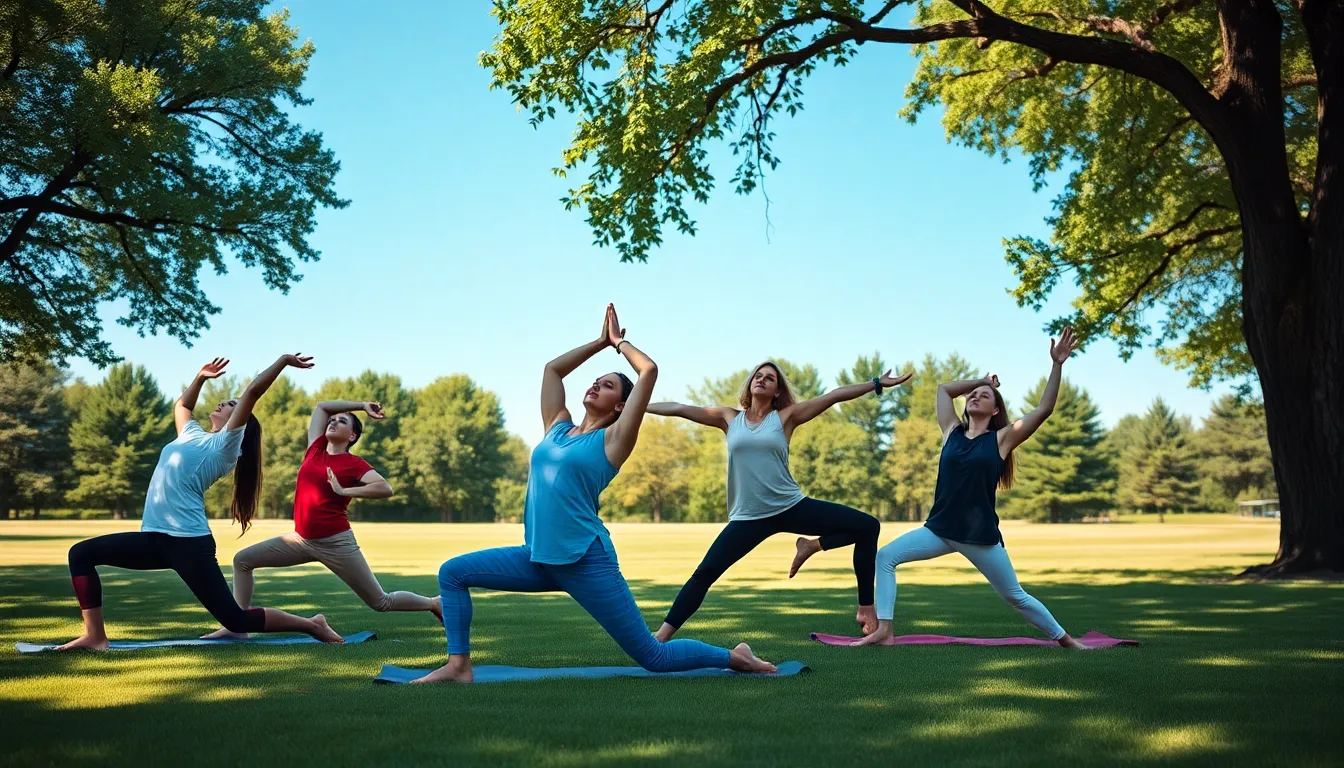In a world where gym memberships can feel like a commitment to a long-term relationship, yoga offers a refreshing alternative that’s as flexible as your hamstrings will be after a few sessions. Picture this: a peaceful studio, soft music, and the sweet smell of lavender wafting through the air, all while you master the art of downward dog. It’s not just about bending and stretching; it’s about finding balance—both on and off the mat.
Combining yoga with fitness can elevate your workout routine from mundane to magical. Imagine sculpting your body while channeling your inner zen master. Whether you’re a seasoned yogi or a fitness newbie, blending these practices can unlock new levels of strength, flexibility, and relaxation. So grab your mat and let’s dive into the delightful world of yoga and fitness, where sweat meets serenity and every pose is a step toward a healthier you.
Table of Contents
ToggleOverview of Yoga and Fitness
Yoga and fitness intertwine to create a comprehensive approach to health. This combination enhances physical strength while promoting mental clarity. Practicing yoga improves flexibility, alignment, and body awareness, contributing essential benefits to overall fitness routines.
Incorporating yoga into traditional workouts increases endurance and reduces the risk of injury. Workouts that combine strength training and yoga offer varied muscle engagements. Many individuals find that yoga facilitates recovery by stretching muscles and relieving tension.
Fitness enthusiasts appreciate the mindfulness that yoga cultivates, leading to improved focus during workouts. This mental aspect strengthens the commitment to fitness goals. Classes often blend yoga elements with aerobic exercises, creating balanced regimens that cater to diverse fitness levels.
Various yoga styles, such as Hatha, Vinyasa, and Ashtanga, provide unique benefits that complement fitness regimes. Hatha focuses on postures and relaxation, while Vinyasa emphasizes movement and breath synchronization. Ashtanga promotes structured sequences for dedicated practice.
Combining yoga and fitness facilitates holistic progress. Both aspects support body functionality, enhance posture, and elevate mood. Regular practice fosters resilience and encourages learners to explore new challenges. Incorporating both practices ensures well-rounded development, allowing individuals to achieve their desired level of health and wellness.
Benefits of Yoga for Fitness

Yoga offers extensive benefits for fitness, enhancing both physical and mental well-being.
Physical Benefits
Improved flexibility results from regular yoga practice, allowing for deeper stretches and greater range of motion. Increased strength develops, as many poses require body weight support, effectively engaging multiple muscle groups. Enhanced balance becomes evident through various postures that challenge stability. Improved alignment supports better posture, which is crucial during any fitness activity. Reduced muscle tension occurs, leading to quicker recovery post workouts. Injuries lessen in frequency due to heightened body awareness, allowing individuals to recognize their limits. Increased endurance benefits cardiovascular health, especially with dynamic styles like Vinyasa. Overall, yoga enriches physical performance and reduces stress on the body.
Mental Benefits
Increased focus is one of the standout mental benefits of yoga practice. Concentration sharpens through mindful breathing and intentional movements, translating to improved performance in traditional workouts. Enhanced mindfulness creates a deeper connection between body and mind, promoting awareness during fitness routines. Reduced stress levels contribute to better overall mental health, helping practitioners cope with daily challenges. Improved mood results from the release of endorphins during yoga sessions, offering a natural boost in happiness. Greater resilience develops as individuals push through challenging poses, fostering a growth mindset. Overall, yoga cultivates mental clarity, inflating commitment to fitness goals efficiently.
Popular Yoga Practices for Fitness
Various yoga practices serve as effective methods for enhancing fitness. Each style offers unique benefits, contributing to overall wellness.
Hatha Yoga
Hatha Yoga focuses on foundational postures and techniques. Beginners often gravitate towards this style due to its slower pace. Individuals develop essential alignment and relaxation through basic poses and breathing exercises. Hatha incorporates stretches that increase flexibility while encouraging body awareness. A consistent practice boosts strength, enhancing physical capabilities.
Vinyasa Yoga
Vinyasa Yoga connects breath with movement seamlessly. This dynamic style emphasizes fluid transitions between postures, promoting cardiovascular fitness. Practitioners experience an energetic flow that builds endurance and core strength. Each session adapts to individual needs, allowing for creativity and personal expression. The rhythmic nature of Vinyasa enhances mental clarity and reduces stress.
Ashtanga Yoga
Ashtanga Yoga presents a structured approach with its set sequences. Practitioners follow a specific series of postures, emphasizing strength and stamina. This style develops discipline, as participants complete each sequence methodically. Individuals enjoy increased muscle tone and flexibility through repeated practice. Ashtanga Yoga cultivates focus, fostering a deeper connection to one’s physical and mental state.
Integrating Yoga into Your Fitness Routine
Yoga complements a fitness routine by enhancing strength, flexibility, and mental clarity. Effectively integrating yoga helps achieve a well-rounded approach to health and wellness.
Frequency and Duration
Incorporating yoga into a fitness routine offers flexibility during training. Practicing three to five times weekly, for 20 to 60 minutes, can yield significant benefits. Short sessions focusing on specific areas can enhance recovery while longer sessions promote deeper relaxation and strength. Consistency builds familiarity, making postures easier and more beneficial over time. Additionally, integrating shorter yoga sessions post-workout or during active rest days maintains momentum and prevents burnout.
Complementary Exercises
Yoga pairs well with various exercises, enhancing overall fitness. Strength training and cardio workouts benefit from increased flexibility provided by yoga. Incorporating yoga sessions before or after lifting weights can improve technique and posture, reducing injury risk. Combining yoga with high-intensity interval training (HIIT) allows for greater stamina and recovery. Vinyasa, as a flowing style, elevates heart rate when blended with aerobic exercises. Thus, a comprehensive routine featuring yoga and traditional workouts supports balanced progress toward fitness goals.
Integrating yoga into a fitness routine offers a pathway to holistic health. It enhances physical performance while nurturing mental well-being. This harmonious blend empowers individuals to achieve their fitness goals with greater ease and resilience.
By embracing various yoga styles, practitioners can tailor their approach to meet personal needs and preferences. Whether seeking strength, flexibility, or relaxation, yoga provides essential tools for a balanced lifestyle.
Regular practice fosters a deeper connection to the body and mind, promoting an overall sense of well-being. Committing to this integration not only elevates fitness levels but also enriches life’s journey.









